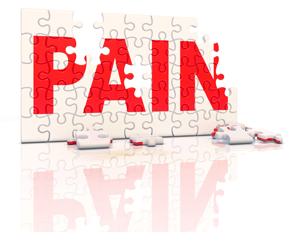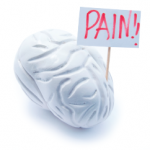
Dmitry3D/shutterstock.com
Who, except the gods, can live time through forever without any pain? —Aeschylus
Pain, swelling, stiffness. These are among the most common words overheard in conversations with our patients. How stiff are you in the morning? Have your joints swelled? Can you rate your level of pain using a 10-point scale?
Discussing aching joints, sore muscles and tender limbs is all in our day’s work. We are rheumatologists; we deal in misery. But trying to parse the true meaning of these terms is among the most vexing of clinical challenges.
True, most swollen joints can be readily observed or palpated, and others might be identified using diagnostic imaging studies. And although it’s a subjective term, the true relevance of stiffness often becomes apparent following a careful review of the results of some simple lab markers of inflammation.
Sometimes, pain plays by the rules and arrives with a retinue of helpful clues; an abdominal pain accompanied by a fever and an elevated white blood cell count demands swift surgical attention to rule out visceral rupture; a pleuritic chest pain with breathlessness often triggers immediate consideration of a pulmonary embolism; a bout of podagra awakening a slumbering patient hearkens the clinician back to Thomas Sydenham’s classic description of gout.
Sometimes, pain can be misleading. Consider the patient with shoulder pain who, in reality, is sickened by their impacted gallstone or the young child whose knee pain and refusal to walk actually signifies an injured hip.
When pain is coy, it presents bereft of any clues. We are all too familiar with these scenarios: the previously healthy, athletic patient with debilitating, widespread pain whose hope for a reprieve from their anguish clings to the spurious finding of a positive antinuclear antibody test ordered by a well-intentioned, although misinformed, clinician; or the person with intractable low back pain following some trivial trauma whose Internet search for help led them astray and into the realm of rheumatic disease. In these situations, you become the bearer of mixed news, having to elucidate how their pain is not due to a defined rheumatologic illness, while also explaining how little we actually understand about chronic pain.
Pain can also be a well-entrenched symptom in many rheumatologic diseases. Consider how some of our patients with an inflammatory arthritis, such as rheumatoid arthritis (RA), start developing vexing pain symptoms. In a typical scenario, their RA is controlled with scant evidence for active synovitis. But then one day, they start to notice pain. Considerable pain. Sometimes the misery is felt in the soft tissues; other times it attacks previously unaffected joints. You examine your patient carefully, seeking any glimpse of the trusted trio of inflammation—swelling, redness and warmth. But there are no sightings. Despite cautious trials of analgesics, corticosteroids and, perhaps, even further immune modulation therapy, there is scant improvement. What is going on? What is driving this new pain?
In fact, the prevalence of chronic widespread pain and fibromyalgia (FM) are significantly higher among patients with RA than in the general population, with some estimates suggesting a prevalence of 20–40%.1 A large Canadian cohort of patients with early RA observed that the incidence of FM was highest during the year after the inflammatory arthritis diagnosis was made.2
When there is discordance between what the patient and physician consider to be ongoing disease activity, it is likely caused by pain. Rheumatologists seek to achieve RA remission by eradicating all joint swelling and reducing disease activity scores to the lowest levels. However, for most patients, eliminating pain is the critical issue, often taking precedence over reducing synovitis.
Although these goals intersect, they may not fully overlap. We may talk past one another as we tell our patients that their RA is in clinical remission while they wonder, with a fair degree of skepticism, why they are still experiencing pain.
A History of Pain
The concept of pain has long confounded clinicians and patients alike. Pain is a complex experience. Traditional Chinese medicine viewed pain as being caused by a thermal imbalance, a clash between heat and cold, instigated by the two opposing principles of yin and yang. Although many of the ancient philosophers considered the heart to be the seat of the soul and all sensations, including pain, Galen (he of dolor, calor, rubor, tumor fame) recognized the brain as the organ of feeling and placed pain into the sphere of sensation. By carefully observing patients in pain, he proposed that pain was a specific characteristic that corresponded to an unpleasant sensation caused by a previously nonpainful stimulus, a phenomenon now known as allodynia.3
From the 19th century through present times, identifying how pain is processed drove discovery in neuroanatomy and neurology as the search for the physical pathways carrying pain resulted in the meticulous dissection of the peripheral nerves, the spinal cord and the cerebral hemispheres.
About 50 years ago, the concept of the gate control theory of pain gained wide acceptance and, although it was subsequently proved to contain flaws, it served the critical purpose of focusing on the importance of pain modulation in pain perception. The theory incorporated newly discovered mechanisms of presynaptic control of transmission from large and small sensory afferents, which was proposed to gate incoming information depending on the balance between these inputs, providing an explanation for how pain perception could be modified by ongoing or prior experiences.4 Clinicians could now integrate affect and mood into the pain equation. It challenged the notion of a tight linkage between stimulus and reaction, because clinical experience suggested otherwise.
Additionally, the theory dealt explicitly with the apparent paradox between the paucity of sensory neurons that responded selectively to intense stimuli and the well-established finding that stimulation of the small fibers in peripheral nerves was required for a sensation to be described as painful.
Is Pain an Immune Response?
Fast forward another 50 years to the adoption of brain imaging techniques, such as functional magnetic resonance imaging (fMRI), as a way to elucidate the maze of pain pathways in the brain. What have we learned from these studies? By analyzing cerebral responses to experimental pain via fMRI, researchers have demonstrated a pain matrix of brain activation, which can be split into medial and lateral pain pathways.5
The medial pain pathway, incorporating the medial nucleus of the thalamus and projecting to the anterior insula and cingulate cortex, processes the cognitive, affective and response aspects of pain, such as learning, prediction, avoidance, attention and anticipation.
In contrast, the lateral pain pathway, comprising the primary and secondary somatosensory cortices, parietal operculum and posterior insula, is predominantly involved in the sensory and discriminative aspects of pain processing, including intensity localization, duration, and temporal and spatial discrimination.
Certainly, functional imaging has helped expose the inner workings of the brain in processing pain. For many clinicians, this might be an engaging topic—but only up to a point. It is in our nature as rheumatologists to try to link clinical symptoms to any potential immunologic underpinnings. Does a link exist between chronic pain and inflammation? Mounting evidence suggests one does. The concept of neuroinflammation—the term used to describe the interaction between brain cells and cytokines—has become a hot topic (see “Can Systemic Inflammation Influence Mood?” The Rheumatologist, August 2015).
A few studies relevant to this field are worth highlighting. The first is an intriguing investigation that asked whether systemic inhibition of TNFα could positively influence central pain processing even before it affects joint inflammation in RA.6 In this small study, fMRI of the brain was able to predict the therapeutic success of TNF inhibition at a very early stage in the course of treatment. As early as 24 hours following a single infusion of infliximab, nociceptive activity in the brain pain matrix was significantly reduced and remained low until the end of the observation period six weeks later. Importantly, this was true even before clinically measurable changes in objective disease symptoms could be recorded or structural effects on the joint, such as a reduction of synovitis on magnetic resonance imaging (MRI), could be detected.
Responders showed significantly higher baseline activation in thalamic, limbic and associative areas of the brain than nonresponders. Moreover, brain activity decreased within three days after infliximab exposure in the responders, preceding clinical responses, which were first noted on Day 7, and responses observed on the anatomic hand MRI, which were noted on Day 28.
The authors raise the tantalizing question of whether the beneficial effects of anti-TNF therapy are initiated in the brain days before the synovium responds. Because we currently lack tests that predict response to costly biologic therapy, the authors ask whether fMRI results might be used to forecast the therapeutic success of cytokine-targeting therapies.6,7
A second study demonstrated how the modification of behavior induced by chronic pain carries a distinct immunologic signature.8 In this study of rats that underwent sciatic nerve chronic constriction injury to create a model of chronic neuropathic pain, it was observed that one of three behaviors developed following the procedure. Rodents exhibited pain and disability behaviors, pain and transient disability or simply pain alone. Some just hobbled about their cages with variable degrees of success, and others lost their usually avid interest in dealing with intruders placed inside their habitat.
Strikingly, for each of these three behavioral attributes, a distinct immune signature developed that could be identified by analyzing specific cytokine levels in the sciatic nerve, the spinal cord and the dorsal root ganglia. These changes correlated with the degree of disability, suggesting that individual immune signatures played a significant role in determining the different behavioral trajectories following nerve injury, which in some cases led to persistent affective and motivational disturbances. Might this experiment mimic what we often observe in patients dealing with chronic pain?
In the third study, mass cytometry—a highly parameterized single-cell-based platform that can determine functional responses in precisely phenotyped immune cell subsets—was used to comprehensively characterize phenotypic and functional alterations of the human immune system as they occurred in vivo in patients undergoing hip-joint arthroplasty.9 The primary aim was to extract “surgery” or “trauma-specific” immune signatures and to determine, secondarily, whether such signatures contain clinical correlates of surgical recovery.
The authors observed that by studying the cell signaling responses in less than 2% of subjects’ peripheral leukocytes, they were able to identify specific cell signaling responses, most notably in CD14+ monocytes, that accounted for between 40% and 60% of the variability in recovery rates. Similar to what was seen in the rodent study, these unique immune signatures correlated well with the levels of pain, fatigue and functional impairment that were measured six weeks postoperatively.
Taken together, these studies and many others suggest a pivotal behind the scenes role for immune regulation in pain processing.
Where Do We Stand?
Despite the mounting evidence linking immunity and pain pathways, there is a hesitation on the part of some rheumatologists to fully embrace pain management. This attitude is understandable given the myriad challenges facing this clinical conundrum—the subjective nature of pain; the frequent need for potent analgesia, including opioids; the accompanying litigious issues regarding the pain’s causation that may need to be addressed; and the perception that pain management is adrift from the core principles of clinical rheumatology.
This concern has been previously raised, with some rheumatologists advocating that chronic pain disorders, such as FM, be managed by other specialties, notably primary care doctors and psychiatrists.10,11 In our June 2015 reader survey, a slim majority of respondents (56% vs. 44%) agreed with the statement that rheumatologists should be managing patients with FM. This conflict of opinion will likely persist until we gain an even deeper understanding of the relationship between pain and the immune system.
But we are rheumatologists. We are accustomed to dealing with uncertainty.
 Simon M. Helfgott, MD, is associate professor of medicine in the Division of Rheumatology, Immunology and Allergy at Harvard Medical School in Boston.
Simon M. Helfgott, MD, is associate professor of medicine in the Division of Rheumatology, Immunology and Allergy at Harvard Medical School in Boston.
Reference
- Lee YC. Effect and treatment of chronic pain in inflammatory arthritis. Curr. Rheumatol Rep. 2013 Jan;15(1):300. doi: 10.1007/s11926-012-0300-4.
- Lee YC, Lu B, Boire G, et al. Incidence and predictors of secondary fibromyalgia in an early arthritis cohort. Ann Rheum Dis. 2013 Jun;72(6):949–954. doi: 10.1136/annrheumdis-2012-201506. Epub 2012 Jul 11.
- Chen J. History of pain theories. Neurosci Bull. 2011 Oct 1;27(5):343–350.
- Mendell LM. Constructing and deconstructing the gate theory of pain. Pain. 2014 Feb;155(2):210–216.
- Jones AK, Huneke NT, Lloyd DM, et al. Role of functional brain imaging in understanding rheumatic pain. Curr Rheumatol Rep. 2012 Dec;14(6):557–567.
- Rech J, Hess A, Finzel S, et al. Association of brain functional magnetic resonance activity with response to tumor necrosis factor inhibition in rheumatoid arthritis. Arthritis Rheum. 2013 Feb;65(2):325–333.
- Sergeeva M, Rech J, Schett G, et al. Response to peripheral immune stimulation within the brain: Magnetic resonance imaging perspective of treatment success. Arthritis Res Ther. 2015 Oct 19;17:268.
- Austin PJ, Berglund AM, Siu S, et al. Evidence for a distinct neuroimmune signature in rats that develop behavioural disability after nerve injury. J Neuroinflammation. 2015 May 20;12:96.
- Gaudillière B , Fragiadakis GK, Bruggner RV, et al. Clinical recovery from surgery correlates with single-cell immune signatures. Sci Transl Med. 2014 Sep 24;6(255):255ra131. doi: 10.1126/scitranslmed.3009701.
- Weinblatt ME. ACR presidential address: The best of times, the worst of times: Rheumatology 2001. Arthritis Rheum. 2002 Mar;46(3):567–573.
- Ghazan-Shahi S, Towheed T, Hopman W. Should rheumatologists retain ownership of fibromyalgia? A survey of Ontario rheumatologists. Clin Rheumatol. 2012 Aug;31(8):1177–1181.
